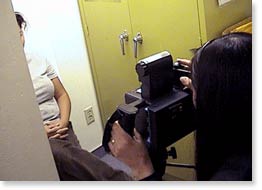|
Immigrant Families in Crisis
A Close-up View of the Violence Against Women Act Eloise de Leon San Diego, California
I had worked for over a year in the same small organization as Bautista before I actually met her. The office that she shares with two legal advocates, Calderón and Cortés, had its doors shut tight most of the time. The three seemed friendly enough at the copy machine but were never seen relaxing in the staff lounge. I frequently saw their clients arrive and get ushered quietly into their office. But I couldn’t find any program brochures or even a program title for them. Finally, I asked, “What do these women do?” Bautista is an immigration attorney and Project Director for the Immigrant Families in Crisis (IFC) program, that carries out services enacted through the Violence Against Women Act. Congress enacted the Violence Against Women Act (VAWA) in 1994, as part of the Violent Crime Control and Law Enforcement Act. Bautista founded the program in 2001 under the auspices of a San Diego non-profit organization with a mission of community empowerment. Bautista is joined at IFC by two legal advocates and eight law interns from two local law schools. The staff make it a priority to create a confidential, secure environment for clients, safe from their abusive spouses. Normally, when an immigrant seeks U.S. residency status, s/he must be sponsored by a legal citizen, typically a spouse or parent. VAWA provides the right for a spouse or child to self-petition for immigrant classification if he or she has been battered by, or subjected to extreme cruelty committed by the sponsoring legal permanent resident spouse or parent. Bautista and her staff assist clients in preparing applications for U.S. status, work permits, and a green card of permanent resident status.
When I first asked Bautista to describe IFC’s services, she spoke a legal language I did not understand. One more try, weeks later, and I was still perplexed. Realizing that I wasn’t understanding the legal terms, I asked, “Can you talk me through a client’s case?” Bautista smiled thoughtfully and began, “Okay, let’s call her Maria.” She remembered the case because it was one of her first, from years earlier. Since she didn’t have the staff support then that she has now, she had to go through every step personally with the client. “Maria” was part of a domestic violence group where Bautista had given a public talk. Maria began to realize how important her immigration status was. Bautista explains, “Without a green card, without a work permit, she couldn’t get what everyone else had which was a driver’s license, a social security card, enter certain buildings and [would] basically be vulnerable to everything.” Maria began to understand the implications for herself and her children. Bautista continued, “I knew what the law required as far as a strong, credible case. The first thing I had to focus on, were her words and her story. I sat with the client and had her explain everything.” The challenge of working with victims of abuse is in observing non-verbal cues that lead to vital information. Bautista listened carefully, “There were certain points in her story that she didn’t want to explain. I knew from my training that I needed to have more detail.” Bautista explained to Maria the importance of documenting difficult details. “The officer will not meet with you in person. The officer doesn’t have the opportunity that I do. I can read your facial expressions. I can see that this is really hard for you to talk about. But the officer is only going to read it on paper. So could you please explain to me what kinds of words he used if you can remember, or if you prefer, can you write them down?” Maria’s husband yelled at her often, calling her derogatory and vicious names. He threatened her by saying, “You have no right to be here. I am a United States citizen. The laws only protect me. I can call and you&Mac226;re going to be deported if you say anything about what I just did.” Bautista states that Maria had no problem explaining the happy times of her marriage, “…but as we got more into the marriage and what was happening that's when she got more emotional. We had to pause. During that time I explained to the client, -‘We can stop this and continue on another day but it might be easier for you to just get it all out now so that I don’t have to bring this up again.’”
Bautista recalls, “We had to include that in the story because that was part of the psychological terror that she was living under. Once we got through the entire story, the client of course, was exhausted and drained and so was I, just having taken in the story and being in that world for three or four hours. I then had to put that together in as clear a format as I possibly could, preserving her words.” Bautista tried to impress upon her client, the need for her to gather documentation for her case. But she didn’t have much to substantiate her story. Bautista states, “She only called the police once, so we only had that one police report. She didn’t really talk to anyone else. She didn’t want letters from friends or family even though they were aware of what was going on.” In spite of the difficulty in putting together the case, Bautista finished the lengthy application and filed it by certified mail with the Vermont Service Center. Since VAWA was a new law there weren’t many cases being filed. Within a month, Bautista received an approval. “But, it wasn’t the green card yet,” she added. Hearing that her case had been accepted, Maria broke into tears. “Because her story had been validated,” explains Bautista. The next step was to apply for a work permit and green card. The entire process took months, due in part to Maria’s need to find money for the applications. Bautista continued to have contact with the client for the better part of a year, providing her with referrals and resources as needs arose. Upon separation from her husband, Maria had problems getting permanent custody of her children. She had to show the court that it would be in the best interests of her children to be with her. She also had to show that she would eventually have a work permit, and a way to earn money and support her children as a single parent. Bautista found the appropriate legal counsel regarding these issues from attorneys at the YWCA. Within the year, Bautista received notice of Maria’s interview appointment with the local immigration office. She explained to her client, “The officer will ask you questions, the officer will want to know if the information is correct but the officer will not be asking you about the details of your problems or the abuse by your husband, because that has already been done on paper with the other immigration office at the Vermont Service Center.” Bautista went on to explain that the sole purpose of the interview with the local immigration office is to finalize the request for a permanent resident green card. The client must declare that she doesn’t have a prior criminal background and is not a potential threat to the United States. Her appearance, with documents in order, prove too, that she is an actual person. Bautista describes her client that day as, “... excited, but she was nervous at the same time. We waited for the appointment for about an hour and a half. It’s hard to assure a client that everything is fine if you see a sea of people all looking just as worried.” Bautista said that people arrive at the immigration office for citizenship papers, green cards, and some arrive alone, just trying to find out how to begin their immigration process. The interview was held in a tiny office between an officer, Maria, and her attorney, Bautista. The law was still new, making Bautista’s presence crucial. Bautista remembers the first question the officer asked, “Where’s the husband? Where’s the petitioner?” Bautista explained to the officer, “There’s no need to have the husband here because Maria X is now her own, self-petitioner.” Bautista noted that the officer seemed a little confused but she was prepared with the law. “Finally, we have a seat and the client has to raise her right arm and swear to tell the truth. She says, ‘I do&Mac226;’ and has a seat. The officer will go through the questions on the list to make sure that her name is spelled correctly to make sure they have the correct address. Usually we use our address for confidentiality purposes and for the safety of the client. The officer will make sure that all the information about the children is correct. The officer was about to ask whether the client was still living with the husband, so I stopped the officer and said, ‘Oh you don’t need to do that. Actually your job is a lot easier now because that&Mac226;s already done and it’s already been adjudicated. You can just go on and ask the questions about moral character.' The officer didn’t fight me on that and went to the next section. He then asked the client, everything on the list.” The “list” consists of a set of questions that Bautista claims would be nerve-racking if they were being asked for the first time. Fortunately, she had prepared her client in advance. The questions include: -- Have you been arrested, cited, charged, fined? The most important questions are: -- Have you been arrested? Bautista said that clients who seek legal status through the Violence Against Women Act are exempt from questions regarding public benefits. “They understand that they may need some extra support to get back on their feet. They try their best to work and pay their taxes so that they are not a burden on the United States but in situations like this, if you’ve just left the home and are staying in a shelter you don’t really have much of a choice." Bautista counsels her clients to explain the details of any public assistance they have received and to describe any job searches, job training, career counseling and their plans towards a stable financial future. Officers must record the information but do not require clients to prepare an “affidavit of support.” The petitioner must provide proof that the applicant will not be a burden on U.S. society. Bautista explains, “This is something that ordinarily the [sponsoring] petitioner would have included in the application, stating that they make enough money to support this person that they want to immigrate. That’s obviously not possible if you are now continuing this process on your own, and have separated probably, from the primary wage earner in the family.” The attending officer checks the medical records to see that the applicant is in good physical health and does a criminal background check. The culminating moment is reached when the officer stamps the applicant’s passport.” Bautista smiles broadly at this point in the story, “That stamp is what the client had been working towards. That stamp is the stamp of permanent residency. That stamp makes her now able to leave the country and come back without a problem, to work and not have to re-apply for a work permit every year, and eventually to be able to apply for United States citizenship, within three to five years.” Bautista recalls her client’s reaction, “Even though I had explained to her over and over again what was going to happen it didn’t really hit her until she saw the officer stamp the passport. She seemed to be frozen in the chair...I looked at the client and asked, ‘Do you have any questions?’ Maria only wanted to know if it was okay to give the officer a hug.” When they walked outside Maria told Bautista, “This is all I’ve worked for. This stamp can do everything.” Maria received her official green card a couple of months later. Only then is the case officially closed. The process for Maria, took about a year and a half. Since her case ended, Maria has found work and is able to successfully support herself and her children.
The IFC office has grown in the past three years to include the team of legal advocates and law interns. Each staff member and intern exhibits a high degree of sensitivity and caring. “This year, six law students from the last two semesters have come back again. We only added two new ones. We’ve been monitored by both Thomas Jefferson and Cal Western and they’re very happy with the type of experiences the law students get here so it’s worth it to them to invest the [funds] so we don&Mac226;t have to cover any money to pay for eight extra law students.” Interest in IFC’s work has increased at the law schools. Eighty resumes were submitted during the last semester. Bautista and her staff divided them into three piles, “We didn’t read the resumes. We read the cover letters. If the cover letter struck us as someone who could relate, if that caught our attention, then that was in the ‘definite yes’ pile. If we didn’t get a feeling for the person or it sounded cold, or it was more a rehash of the accomplishments rather than why I want to do this kind of work and this is what I learned about you, then those would go in the ‘definitely not’ pile. And if there was a little bit of sincerity there and a little bit of the other stuff that would go into the ‘maybe’ pile." Law intern, So, recognizes VAWA’s importance, “Because of the situation that they [victims of abuse] are in, sometimes they feel confused or lost or scared and they don’t know where to turn. This is a good law because it gives them the resources to break away from the abusive spouse and make a fresh start on their own.” Bautista, Calderón and Cortés caution the interns, “This is not your traditional legal firm. This is not your traditional legal clerkship. "Although there is no formal training in counseling skills, it is evident that the staff regards compassionate, patient listening a necessary skill. For example, Cortés instructs interns not to use the phrase, “Actual evidence of abuse” preferring to ask, “What kinds of problems have you had with your husband? Have you had to call the police?" When a new intern appears a little harsh, Cortés says that they are helped to push for details in a different way. Cortés points out, “Some clients are emotional. I let them talk, I let them vent, because we may be the first person that they’ve contacted and told about the abuse.” Browne is Development Officer, in charge of raising funds for the IFC program. “It’s always a challenge -- because the topic is controversial. When I first started working with funders they would have this knee-jerk reaction over what they thought about it, “Oh that’s immigration,” or “That’s another country’s problem,” or “we should be taking care of our own.” It took so long to explain and get over their reactions. But, it’s the law. It already is. The law has determined [it to be illegal] to use somebody’s immigration status as a tool that can be used against them, more powerful than fists or control over their finances. What I’m looking for are funds, not trying to establish whether it should be done or shouldn’t be done. I’m learning that if I have to explain why it’s a law and why it’s needed, for too long, it’s not going to amount to anything.”
Browne explains that there are approximately one-hundred agencies that make referrals to the IFC office. Thus, each agency can declare to their funders that they participate in the IFC project. Consequently, funders oftentimes believe that they are already funding the work. But it’s not going to direct client services for domestic violence victims. The referral system is an important underground network comprised of many different kinds of agencies. Health clinics are one kind of referral site. “Abusers are very controlling and know where their wives are going at all times. They wouldn’t let them have contact with this kind of an organization. But they do need to get patched up after they’ve been beat up, they do need birth control, they do need medical treatment so they can go to clinics [and get referrals].” Browne continues, “We spent four years developing this system of referrals and it works and it’s effective and it serves as many people as we can serve and we can’t risk that to get publicity. So, it’s extremely challenging to find the funders that understand it, that are receptive to it and that will support it. They have to do it from their heart [because] it’s the right thing to do. It means that I have to hit the same people up over and over again. But you do what you gotta do. It’s the only way for these women to break free. They can’t go to shelters, they will not go to the police, they will not go to the District Attorney, unless they know that they aren’t going to be deported or separated from their children or the life that they’ve established here.” To re-answer my original question, “What do these women do?”, Calderón reminds me of the purpose of IFC’s work, “Before the law was passed in 1994, the person with status had complete control over the process. Now the woman can have some control over it, herself. We wouldn’t need this law if the man [spouse] would do the paperwork. We’re not here because they hit their wives. We’re here because they didn’t do the paperwork. If men did it, we wouldn’t need this law, there would just be more women who could access shelters and those core domestic violence services. It was because abusers realized that that was an essential part of controlling the immigrant’s life that the law was written. It took a long time to get it written and on the books.” Eloise de Leon is an artist coach, writer and filmmaker currently living in New York. Her articles may be found in the Art Changes and Human Rights / Civil Rights sections of In Motion Magazine. Her website is: www.insightandjoy.com and her email is: eloisemargaret@gmail.com. Published in In Motion Magazine - May 16, 2004
Also see:
|
||||||||||||||||||||||||||||||||||||||||||||||||||
Copyright © 1995-2013 NPC Productions as a compilation. All Rights Reserved. |
||||||||||||||||||||||||||||||||||||||||||||||||||






